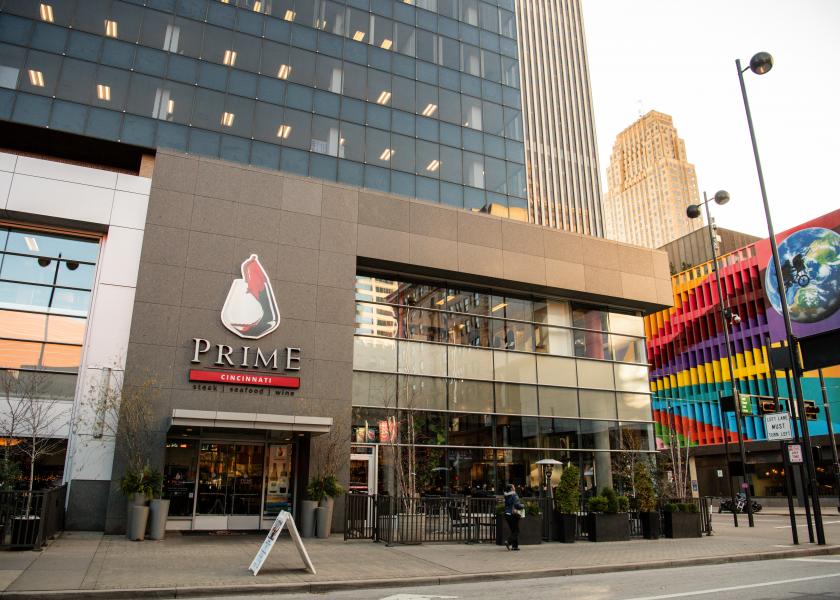The Winding Road to Prime

At Walnut and East 6th in downtown Cincinnati, a vibrant mural shows Neil Armstrong with a lunar movie camera, seemingly trained on a steakhouse rather than a moonscape. If anyone could watch the film over the last few years, what a story it would tell.
When the mural went up in summer 2016, the view took in Prime 47, a steakhouse barely hanging on. Many a passerby might’ve asked if or why it was still open. But a transformation was beginning inside.
Today, everyone from downtowners hustling in for lunch to evening diners from hours away all rave about what is now Prime Cincinnati. They may savor anything Certified Angus Beef ® (CAB®) brand Prime meat balls to a dry-aged CAB chuck short rib with bacon risotto.
Executive chef Shawn Heine is proud of the transformation and success since he started.
But it was no easy feat getting there.
He grew up working on a dairy farm in central New York and did a lot of physical labor like brick-and-cement work—until summertime would roll around and restaurants needed the extra hands. Heine liked that better than masonry and began applying for steady work.

Shawn Heine
Two restaurant owners out for a bite hired the young man outside an establishment that had just turned him down.
Heine never left the culinary world after that.
From Delaware to Miami to Chicago to New York and back several times, Heine lived in eight states and learned his way around a hard-earned education in classrooms and kitchens.
At one point, he was working at Mon Ami in Boca Raton, Fla., and going to culinary school at Johnson & Wales in North Miami. Working 40 to 50 hours and going to school for 30 hours a week, every dish and paper was a step closer to the main stage.
That time came soon after he met his wife, Ashlee, while working at the upscale eatery, Fulton’s on the River in Chicago. When she was done with school, Heine followed her back to her hometown of Cincinnati and after a couple of other jobs, found work at Prime 47 as the executive chef.
He had to have wondered about his prospects there.
“It was me and one other cook and dishwasher working, and hoping we get a couple tables that night,” Heine says. But the place would usually be near empty.
It was summer 2016 and some world-famous Brazilian was working on the mural across the street while Heine worked to revamp the whole menu inside the steakhouse.

Mural of Neil Armstrong with a lunar movie camera.
Already accustomed to fresh, high-quality seafood from past experience, the chef began researching what quality meant for beef and what was now “his” steakhouse.
“I was using just USDA Choice and Prime, and I didn’t really know any better,” Heine says. “So, I really got into the aspect of, ‘what’s the quality of steak’ and for about two-and-a-half years now, I’ve been Certified Angus Beef.”
Now? Prime Cincinnati is regularly doing $10,000 to $20,000 nights in sales with eight cooks and two dishwashers. Heine watches the reviews get better daily as his restaurant grows from 8% to 18% year after year.
It all comes down to quality, he says, the success and the reason he sells CAB Prime for most dishes.
“I don’t like using subpar stuff; I’m not a subpar kind of guy.”
His standards are really high because he knows his guests’ standards are high. When they come into Prime Cincinnati and expect to spend “a couple hundred dollars” for a meal, it’s a responsibility he doesn’t take lightly.
Heine says he wants something that’s not just going to be remembered two to three weeks from now, but a month or two after when they think about their next steak.
“I want them to have had the best—the Prime meal that they came for—so they remember us down the road and come back,” he says.
Despite all the success, Heine knows if he were to have a star on the Walk of Fame, it’s all thanks to his costars, the ranchers providing the high-quality beef he serves up every night.
“I think it’s an all-out team effort from everybody,” Heine says. “It starts with the ranchers and ends up on my guests’ plates. Without the ranchers, I couldn’t do what I was doing and vice versa. We’re just one big team. It’s a pleasure to be able to serve the meat they produce.”
Heine wants the cattleman to know he’s doing what he can to provide value back to the ranch.
“I’d just like him to know I’m not a guy that just buys steaks and cooks them,” he says. “I’m utilizing the beef as best I can to bring in every dollar I can to make his life a little easier, for our team and our customers.”
That includes being an ambassador on behalf of the brand and ranchers.
Many customers are people who come in on a daily basis. Heine says they’re always grateful because he builds their beef knowledge and educates them on what a good steak is, and all that’s gone into it.
In 2020, he’s hosting a benefit dinner, with ranchers explaining everything it takes to raise the very steak in front of the diners.
“I want my guests to appreciate what they’re eating,” Heine says. “They’re not just eating a steak.”
It’s probably why Prime Cincinnati won the 2019 CAB Steakhouse of the Year award.
Future restaurant ventures for Heine are varied, but all will serve the brand. For now though, if we found a way to view Armstrong’s film of success across the street, we would all enjoy the happy ending.







